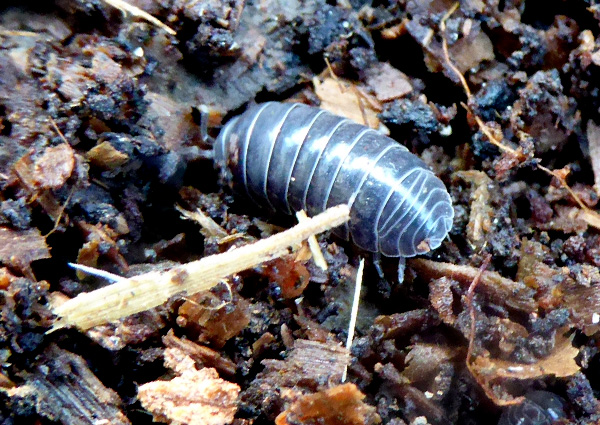
If you check the soil in our beds you will see them scuttling around: grey, 7 body segments and 14 legs, up to 2 cm long and 0.5 cm wide, curling up into a ball when disturbed: in Australia they are called slaters, they are also known as woodlice, roly-polies, pill bugs and by many other names.
Slaters are one of the few crustaceans that make their life on land. They are related to shrimp and crabs, but they are supposed to taste very bad. A moist environment is perfect for them, they feel very comfortable in our compost bins, where they help to break down plant material. When we add compost to the soil, adult slaters and slater eggs end up in our beds in huge numbers. Loving a cooler, more moist and dark environment they are most active at night.
Slaters are mostly beneficial to our garden. They turn over the soil and are important partners in making compost. When they appear in huge numbers in a garden bed they can become a problem. They confuse tender seedlings with weak plant matter and attack it, they will also eat over-ripe fruit and they love strawberries.
If slaters are a problem in a bed, there are several strategies to deal with them:
- Simply scoop them off the soil and bring them back to the compost.
- Add a couple of slater hotels to the bed: fill a small pot with a mix of damp mulch and soft rotting veg and fruit from the compost. Turn them over onto the soil in the bed. Make sure there is a way to enter the hotel. Slaters enjoy this moist, warm and dark environment with lots of food much more than the dry garden bed. Check the hotels at least once per week. When well occupied. resettle the slaters to the compost and replace with a fresh hotel.
- Protect the seedlings you planted with a small wall of course diatomite scattered around their base, it seems that slaters don’t like crawling over diatomite. The wall needs to be checked after rain.
- If they become a real problem in a bed, you can dust them with fine diatomite which will reduce the count drastically.
On diatomite
Diatomite also known as diatomatious earth is a sedimentary fossil that crumbles into fine granules or dust. The dust dehydrates the animals and lacerates their skin. It’s commonly used in grain storage and in treating problems like bed bugs. They formula of diatomite we use is amorphous and not crystalline, which makes it safer to use, but we do advise not to breathe in the powder in large quantities. Dissolved by water it brakes down into trace elements that feed our plants.